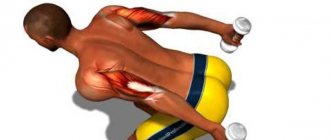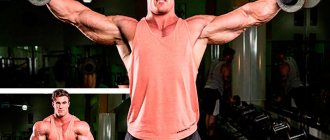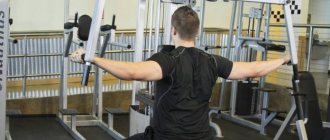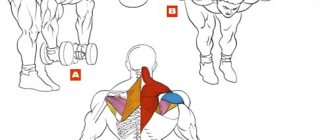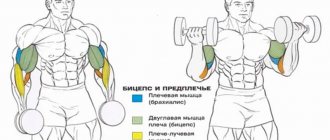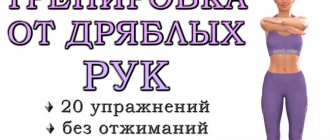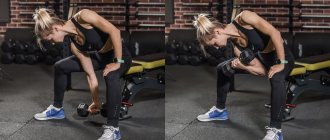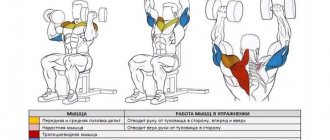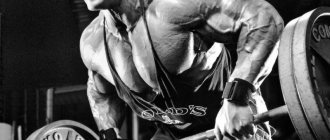You can’t see the muscles, so you don’t need to pump them? Wrong. The posterior bundle of the deltoid muscle is not just some small thing, but also an important link in the prevention of injuries. Bench presses, rows, deadlifts, and even squats become safer when the rear delts are well developed. In addition, the shoulder girdle looks more massive and harmonious if they are pumped up. And your posture is more attractive. Developed posterior deltoids help to expand the shoulders and protect the cervical spine from overload during normal sedentary work. Bent-over dumbbell raises are a movement that develops this part of the deltoids and improves posture. How to do it correctly?
Need to know
The exercise we are considering is designed to work out the rear deltoids. The back of the deltoid muscles allows the arms to move up and back. Without these muscles, the mobility of the arm would be incomplete.
Bent-over dumbbell lateral raises are an exercise that makes sense to be done last in the workout. Despite the fact that it is actually intended for the shoulders, it is usually performed on the day of the back, since in the independent version it loses all meaning.
The rear deltoids are not as vulnerable as the middle or front deltoids, so they can be exercised even after heavy load on the upper back.
For example, today you did pull-ups, block rows, biceps curls. Finish the workout with a bent-over exercise. Do 3-4 sets of 10-12 reps.
If you experience pain while moving your arm up and back, you should not do bent over dumbbell swings. Let the deltoid heal, then you can do such wiring.
If performed incorrectly, the load from the necessary muscles goes to the trapezius, round and rhomboid muscles. This will prevent you from achieving posterior shoulder hypertrophy.
Let's sum it up
Dumbbell flyes are a great exercise for getting rid of slouching. It loads exactly those muscles that are responsible for maintaining good posture - the back of the deltoids, trapezius, rhomboids and the top of the latissimus.
Dumbbell swings also help strengthen the rotator cuff, the most vulnerable part of the shoulder. This significantly reduces the likelihood of shoulder injury while playing sports.
- Dumbbell swings can be performed with or without wrist rotation. For most athletes, the first option is better.
- Find the optimal position of the body: it can be parallel to the floor or located at angles of 45 degrees to the vertical.
- You can rest your forehead on any suitable object to relieve stress on your neck and back and concentrate on working the back of your shoulders.
- Do not lift your shoulders up, this will take the load off the rear deltoids.
- The range of motion should be small - this is also necessary in order to maximally load the target muscles.
Technique: standing bent over fly
If all the benches are occupied, you can do the exercise while standing in front of a mirror. It is important that you see yourself in the reflection.
Take 2 dumbbells weighing 3-4 kg (believe me, if you are a beginner, this is more than enough).
- Stand at a distance of 1–1.5 meters in front of the mirror.
- Feet shoulder-width apart, feet parallel. Bend your knees slightly and lean your torso toward your hips. Keep your back straight, but do not raise your shoulders. The trapezoid should not be turned on. It is advisable to bend to an angle of 45–60 degrees relative to the floor.
- Fix your gaze straight, to do this, slightly raise your head up.
- The dumbbells need to be rotated so that their handles are oriented parallel to the feet. Bend your arms slightly at the elbows, fix the angle.
- Remember that your elbows will need to move upward. Therefore, when you start moving your arms to the sides, turn your arms so that your elbows are pointing towards the ceiling.
- Try not to squeeze your shoulder blades together - work purely with the posterior deltoid muscles.
- Raise your arms until they are parallel to the floor. Hold this position for 1-2 seconds and 5-10 seconds on the last repetition.
From the outside, you look like a bird flapping its wings.
Bent over dumbbell lateral raises are a very subtle exercise. Minor deviations from correct technique will render the training useless. Therefore, let's look at the most common mistakes and what can happen as a result.
Indications for use
The rear deltoids compensate for tensions resulting from disproportionate muscle development in the front of the body relative to the back. Most of a person's daily tasks are in front of his eyes.
People reach for objects, lift them, and perform other actions strictly in front of them. As a result, an imbalance is formed between the muscles of the facial part of the body and the back. The result of this process is a stoop and rounded shoulders. In order to avoid these consequences, you should train the internal back muscles, rear deltoids and rotator cuff.
Errors
These points of error can make the exercise ineffective and harm your health:
- Small tilt angle. In this position, the middle bundle of deltas works. If you want to pump it up, you need to do other exercises, for example, standing dumbbell flyes.
- The elbows are turned back - in this position the necessary part of the shoulder is not loaded again. Elbows should look straight up, at the ceiling, at the sky. Keep an eye on this.
- Arms straight - other back muscles are involved in the work, although you were only going to pump the back of the shoulder. Why do you need this?
- When the weight is heavy, the arms bend during the exercise. The angle at the elbow joint should be fixed at all times. If you feel that you cannot perform a single repetition (or few) without curling your arms, take a lighter weight.
- For beginners, it is difficult to tense the desired muscle; they do not know (because they have not yet felt) what should work in a particular exercise and what should not. Therefore, they swing in an inclined position in such a way that they strain their entire back. The correct technique and awareness of how to work will come later along with training experience.
- Round back. You are in a slanted position. If you round your back, the load will fall on your lower back, which may not end very well. The correct position for this exercise is a bend in the lower back.
Contraindications
This exercise is not recommended for those with shoulder injuries. It is also worth paying close attention to the situation if injuries occurred and subsequently went away. With a heavy load there is a risk of relapse.
Do not lift dumbbells through pain. With the correct technique, only one thing is felt - a burning sensation in the rear delts. Try next time to just warm up more thoroughly and lift less weight.
In case of back injuries, it is better to avoid doing extensions in a standing position, since when bending upward, in addition to the shoulders, the spinal discs also work.
Bent over swings while sitting on a bench
For those who find it difficult to swing dumbbells to the sides while bending over in a standing position, an easier option was invented - sitting on a bench. It places your torso on your knees (literally).
The technique is like this:
- Find a bench, take small dumbbells.
- Sit on the edge facing the mirror. Bring your knees together.
- Lean forward with your back straight. Reach your chest to your knees and stop in this position.
- Your chest rests on your lap. In this pose, you reach 60–70 degrees of inclination relative to the plane of the floor.
- From this position, you will reach your hands to the floor. That is, the dumbbells are on the floor on either side of you.
- Take them and begin to lift them, trying to turn your elbows towards the ceiling. Without this, you will download something else.
- Do 3-4 sets of 10-12 reps. Don't forget to warm up well before the exercise. The rear deltoids can also be pulled. The muscle is small, but the force it creates is quite large.
Don’t forget to breathe correctly when doing dumbbell swings while sitting: when we raise our hands, we exhale, when we lower them, we inhale.
In this position, the knees press on the chest, making it difficult to breathe fully. Therefore, try not to lie completely on your knees.
Features and Benefits
The rear delts are the main muscle groups that are affected by this training. However, if it is performed correctly (the back must be straight), then proper distribution of the load allows you to additionally pump up all the muscles of the shoulders and the trapezius muscle of the back. In addition, you can strengthen your hands.
When performing a lift, energy is effectively consumed, which makes it possible to quickly lose excess weight and get the athletic figure desired by many men. Exercise allows you to improve your posture and provide additional muscle support for the cervical spine. Since the greatest load falls on a certain muscle group (rear delta), it is classified as isolated.
If you do not follow the correct technique for performing the exercise, you will not be able to add volume to your shoulders.
Approaches can be performed sitting or standing. Sufficient load is provided by 10–15 repetitions and 3–4 approaches. If there is pain when moving your arm back, it means the muscle is injured and you should postpone exercise. The exercise should complete the workout - to avoid injury, the muscles need pre-warming.
Muscles working during the exercise
Subtleties of weight selection
For the first workout, you need to take the smallest weight available in the gym. Usually it is 1–2 kg. Don’t be shy – your task is to develop the technique. And all this is worked out on light weights.
For the second workout, that is, in a week (it is better to train the rear deltoids once every 6-7 days). You will already take 3-4 kg. In the first month it is better not to chase the scales, as well as later. Work in a way that makes you feel comfortable. Let your body remember the necessary movements.
When adding weights, make sure that the dumbbell raises are performed correctly! If your arms begin to bend more, you cannot move them to the desired position - the weight is heavy.
This is an isolated shoulder exercise and is not a strength exercise. That is, regardless of whether you do bent-over dumbbell flyes with 15 kg dumbbells or 5 kg, your task is to do everything efficiently and get the maximum benefit. Then the effectiveness will be maximum.
If you don’t have back problems and have good stretching, then do bent-over dumbbell raises while standing. The sitting option is more comfortable, but relaxes your back.
Useful tips and tricks for doing the exercise
In bent over raises with dumbbells, technique is important; if the movements are incorrect, the back will work instead of the rear delts, and the exercise will lose its meaning. There are general recommendations for performing this exercise:
- Choose light or medium weights, increase the weight gradually and start doing this no earlier than after several workouts.
- Rear delt training should be done regularly, 1-2 times a week. It is logical to include them in the general program on hand.
- Make sure your shoulders don't rise with your arms and your back doesn't slouch. Under no circumstances should the shoulder blades be pulled together.
- During the entire exercise, the elbows should be fixed and directed upward. Don't lower them, they should always be above your wrists.
- Do not allow rotational movements in the shoulder and wrist joints - this can injure them.
- Do not lift the dumbbells too high; the optimal level is the shoulder line.
- When you lower your arms, do not relax your muscles, this will worsen the result.
- The exercise will be more effective if performed at the end of a back or shoulder workout.
- If you experience pain during exercise, postpone it until another day. If this situation occurs regularly, consult a doctor.
- If your elbows bend too much during the raise or you can’t raise them to the desired level, then the weight of the dumbbells is too heavy.
Interesting fact: bent-over weight raises are included in the mandatory training program in various sports: archery, rowing, swimming, wrestling, gymnastics, tennis, volleyball.
The deltoid muscle is relatively small and will take less time to develop than, for example, the muscles of the chest or hips. The rear delta is used by some basic exercises: pull-ups, vertical pull-downs, bent-over barbell or dumbbell rows, T-bar rows. But such exercises are aimed primarily at working large muscle groups, so their effect on the posterior bundles is indirect. Thus, the bent-over dumbbell fly is not the only exercise for the rear deltoids, but it is very effective.
Shoulder anatomy
We already talked about the anatomy of the shoulders in an article about how to pump up the deltoid muscles.
So, the deltoid muscles, as we know, are divided into three parts:
- Front.
- Middle (lateral).
- Rear.
Each part (each bundle) performs its functions:
- Front delta – raises the lowered arm up, bends the shoulder, while simultaneously turning it inward.
- Rear delta – lowers the raised arm down, straightens the shoulder, while simultaneously turning it outward.
- Lateral (middle) delta – moves the arm to the side. When the entire muscle contracts, it abducts the arm approximately 65-75 degrees.
In general, at the link above you can read all the more complete information and nuances of the anatomy of your deltas.
Triceps exercises
The triceps (triceps brachii muscle) is responsible for straightening the elbow (straightening the arms). Decent arm development is the biceps and triceps. Therefore, the triceps should be prepared and developed as actively as the biceps. Let's take a look at how you can improve your triceps at home with a few handy dumbbells.
- Movement of the dumbbell up and down from behind the head with one hand . Stretching your arm with a dumbbell behind your head is perhaps the most popular exercise at home. Stand up straight with dumbbells in one hand. Raise your hand, at this time place your free hand on your belt, lower it down or “hug” yourself (like Arnie on the left). Rotate the dumbbell forward. Start by slightly curling your arm, moving the dumbbell behind your head. The shoulder part does not move, only the forearm works. After you have stretched your triceps well, pause in this position and carefully raise your arm. Repeat the exercise. The dumbbell overhead press can be performed either standing or sitting.
- Move the dumbbell up and down from behind your head with both hands. Before performing a bench press, test the apparatus for resistance. If the dumbbell is heavy (15-20 kg or more), use a sports belt. Grasp the dumbbell plate with both hands. For safety, grab the bar with your thumbs. Stand straight with your legs wide apart (you can do the exercise while sitting). Raise the dumbbell above your head. Now smoothly move your hands behind your head, bending them at the elbows (just don’t pull them in different directions). Do you feel a stretch in your triceps? Extend your arms using your triceps, take your time. Repeat the exercise.
- French press with dumbbells. Lie on a bench or on the floor. The head and legs are pressed tightly together. Stretch your arms with dumbbells up (parallel to each other) and slightly tilt them towards your head. Inhale: Bend your arms smoothly and gently (don't hit) lower the dumbbells until they are on either side of your head. During this time, the elbows are fixed in one position. Exhale: actively extend your arms. In the upper position, freeze for a split second and repeat as many times as necessary. During the exercise, watch your elbows - they should be practically motionless. We recommend using this weight so that you can do about 10 reps without any difficulty.
- Bent over arm stretching with dumbbells back . Stand up, put your feet in a firm position, bend your knees slightly and lean forward. The back is straight. Place your free hand on your knees and bend your working arm at a 90° angle, bringing it closer to your body. Inhale and straighten your arm back, extending it. At the end of the movement, exhale. This exercise is great for strengthening your triceps.
Variations of the exercise
There are a large number of variations of dilutions, in particular the following:
- seated dumbbell raises;
- standing breeding;
- breeding on a crossover block while sitting;
- Breeding while lying on a bench.
Tips and technical details
There are a lot of subtleties and nuances when performing dilutions, so remember them, and then the technique will always be at its best:
- the rear delta does not like heavy weights, so use dumbbells of adequate weight;
- the exercise requires very strong strength of the torso muscles to stabilize an uncomfortable stance, so beginners are better off starting from the “frontal” place of the option;
- while moving, do not let your elbows walk behind or in front of your shoulders;
- do not drop your elbows and always keep them above your wrist;
- breeding should resemble the flapping of a bird's wings;
- hold the brushes as if you were pouring water into a glass;
- do not rotate your arms and wrists;
- do not cheat when moving upward, trying to set the momentum with the help of your torso;
- when doing a bent over fly without head support, the back should be almost parallel to the floor;
- focus on controlled movement of the dumbbells, do not rush when moving them up and do not throw them when moving down;
- it is necessary to constantly maintain a slight (about 20 degrees) bend in the elbows, this is how the load will fall on the target muscles;
- adjust the height of the bench (fulcrum) in accordance with your height and ease of execution;
- It is always better to start shoulder training with the lagging posterior beam.
Well, that’s probably all the advice and recommendations regarding the exercise technique. Let's sum up all this chatter and say goodbye.
Execution technique
Initial position:
- Spread your legs slightly and bend your knees slightly.
- Bend your torso forward slightly above the horizontal, bend your lower back, and keep your back straight.
- Hold dumbbells in slightly bent arms at the elbow joint opposite the shoulder. Grip straight or parallel.
- Shoulders are relaxed and down.
- Head up, look forward.
Movement:
- As you inhale, without bending your arms any further, raise your arms almost to a straight line with your shoulders.
- As you exhale, lower your arms to the starting position.
- Repeat the planned number of times.
Attention!
Recommendations!
Execution options!
